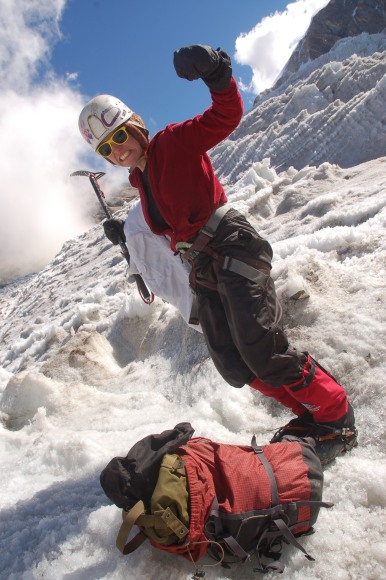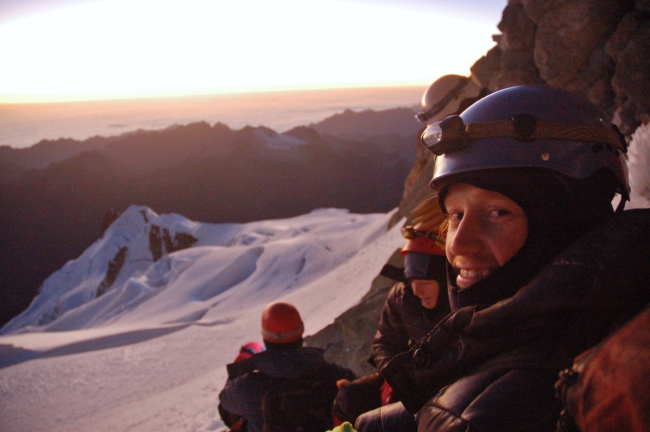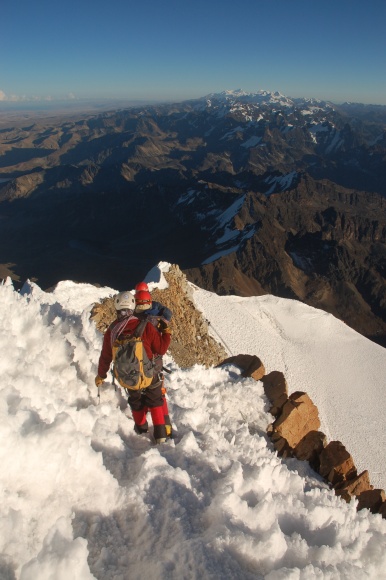La Paz, Bolivia (July 8 – 12)
On our first morning after arriving in La Paz, we met up with Mark and Becc (the Australian couple with the VW bus who we met on the road, check out their account of the climb here) to choose a guiding company for a climb up one of the surrounding mountains.
Although I was initially unsure of whether I would come along (high-altitude mountain-climbing has always seemed to me like a bit of a pursuit for masochists), it was hard not to get swept up in the excitement of the idea while we perused possible itineraries and discussed glacier-climbing and ice-picks. In the end, we chose a company called “Climbing South America,” paid the price (about 200 Canadian dollars for the 3 days, with transportation, equipment rental, meals, beds and guides included), and tried on our equipment.
On the morning of the 9th, Mark, Becc, Tristan and I got loaded into a van and driven up to the first “refugio,” at 4700 m. Because we chose the 3 day option, we got to spend our first afternoon climbing up the sheer face of the nearby glacier with crampons and pick-axes and then relaxing down at the refugio, drinking enormous amounts of tea and hot chocolate and hanging out (a really nice perk of mountain-climbing, it turns out, is lots of time to drink tasty things and chat with friends).
Our second day was almost equally cushy; after breakfast, we hiked up to the second refugio, at 5130 m. It was a difficult walk, especially as we were carrying all of our equipment (including our heavy ski-boot-like mountaineering boots) on our backs, but when it was over we once again had the rest of the day to eat, drink tea, and sit around. The view out the window of our dormitory was incredible: huge, snowy peaks looming just behind us, reminding us of what was coming.

We thought we were tough until we saw the cooks hiking up to the high camp wearing sneakers, skirts and petticoats.
That night we all got into our sleeping-bags around 7 p.m., to prepare for the 12:30 a.m. wake-up that was coming.
Huayna Potosi, which is part of the Cordillera Real, is one Bolivia’s most popular mountains to climb. This is partly because of its proximity to La Paz, and partly because it is a good option for inexperienced climbers, due to its un-technical nature. Its summit reaches 6088 m.

We barely needed headlamps for the first couple of hours of hiking, with the moon shining so brightly on the snow.
When we all woke up in the middle of the night, the puddles of water on the ground outside were frozen solid and the nearly full moon was shining brightly. We put on our long-johns, pants, snow-pants, shirts, sweaters, winter coats, balaclavas, gloves, mittens, two pairs of socks, mountaineering boots, helmets and headlamps. We carried snacks, bottles of water and thermoses of tea in our backpacks, and when we got up past the rocks we attached our crampons to our boots, got our pick-axes at the ready and watched as our guides attached our safety ropes. By the time we were on the move it was 2:15 a.m., and we had about 5 dark hours of very slow upward progress ahead of us.
Walking uphill is one thing—even walking uphill across a glacier in the middle of the night is something that I can imagine doing without a huge amount of trouble. But walking uphill at an altitude of over 5000 m is another thing entirely. I have never moved so slowly. When I have hiked in the past, I have definitely found it challenging, but in a very different way. My muscles usually complain, I get a bit out of breath from the exertion, I get hungry. Here, it was instead a game of patience. Mostly, my muscles felt fine; I was never hungry. But to maximise the chance of making it to the top, we had to move at a snail’s pace. Anything faster and our lungs would fall behind the work, and our heads could start to pound. Every 30 or 45 minutes we would stop for a break—just long enough to drink some water and catch our breath, but not long enough to let the sharp cold get too far into our many layers. And then it was back to our march: one foot a few inches forward, then the other, plant your pick-axe, and start again. I was roped in between our guide, Julio, who led the way, and Tristan, who followed behind me. If one of us slipped when we were walking along a steep drop-off, we were relying totally on Julio to react quickly enough to keep all three of us from tumbling downwards. We were happy to have an extremely experienced guide: Julio has been taking hikers up Huayna Potosi twice a week, on average, for 10 years.

There was one technical bit where we got to use our glacier-climbing lesson: holding onto a rope and using our ice picks we pulled ourselves up a couple of metres of ice above a crevasse.
As we walked, my eyes mostly stayed on the snow just ahead of my feet, and I tried to latch onto thoughts distracting enough to keep my mind off of the task at hand. Every once in awhile I would glance around at the surreal landscape stretching out around me, at the lights of the climbers ahead of us, or at the moon, and it would occur to me that I was climbing up a mountain in Bolivia.
We made it to the summit just after sunrise, around 7 in the morning. Because of the popularity of the climb, we had to jostle a bit for sitting space among the dozen or so other climbers at the top.
With the sun finally warming us, we were able to take a few minutes break to nibble at our snacks and watch the landscape light up far below us. It was a pretty triumphant feeling, looking down and realizing how far we had come—and also being able to celebrate making it all the way to the top. We had been prepared, both by online accounts and by our guides, for the fact that quite a few climbers turn around partway up the mountain. I had come to terms with the idea that the experience would be worth it even if I didn’t make it to the summit, but it felt pretty good to be up there watching the sun come up.
Although we had taken a couple of painkillers and altitude pills along the way to ease headaches, the altitude sickness set in with some more force once we had arrived at our destination. But after all, we had only made it half the distance; we still had to tackle the descent to our second refugio, followed by the hike back down to the road access. And let me tell you, at that point, several hours of hiking was really, really not what I felt like doing. At all.

Hours of walking back across the glacier while the sun heats it up and reflects up at us from the ground.
As we began to make our way back down (taking much bigger steps than we had been able to on the way up), I understood why most mountaineering accidents happen on the descent. It was hard to keep from stumbling, hard to remember to step widely (so that the crampons didn’t trip me), and we had run out of water, so our headaches got worse the further we went. Since the sun was up, our breaks could be longer, but mostly I just wanted to make it back to the refugio and collapse (matters were made a little more urgent by the fact that I needed to pee very badly—and it is hard to pee, as a female, when you are attached by rope to two other people and are wearing a harness and three layers of pants).

The refugio at high camp (5130 m). Inside there was a long table usually full of teas, hot chocolate and snacks, as well as a bunch of bunk beds.
By 10:30 we made it back to the refugio, where hot soup was waiting for us. After our early lunch we packed up our stuff and hiked back down to the road access at the first refugio, a hike which felt improbably longer than it had the day before when we had ascended it. All four of us slept right through our van-ride back to the city, and after a quick stop for a popsicle we parted ways with Becc and Mark and made our way back to the Casa de Ciclistas to lie down and stay immobile for many hours.
After travelling just the two of us since December, it was so great to have had Becc and Mark’s company for a couple of days; on the road one becomes even more appreciative of how nice it is to meet people who are easy to get along with and fun to have around. And since we’ve been semi-constantly on the move, we’ve rarely gotten to chance to spend more than one day with anyone we’ve met along the way. Getting to socialize and trade stories with the two of them was a big perk of going on the climb!
On Saturday evening (after a much-needed day of lazing), the kitchen in the Casa de Ciclistas became a bustling hive of activity as Brendan, from Ireland, prepared stacks of pizzas to feed the hordes of cyclists, and Paul, from France, baked a cake for dessert. Beers appeared, all twelve cyclists were crammed comfortably into the living room, and we had a long, multilingual night of exchanging stories and feasting.
Today Tristan and I plan on checking out the Sunday market and then heading over to a pub to watch the final World Cup match between Germany and Argentina with Becc and Mark. On Tuesday morning, we’ll be getting up out of the city and heading south, towards the salt flats.
– Avalon












